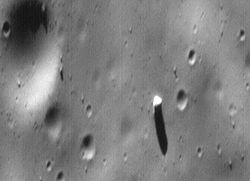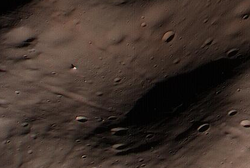- Phobos-Monolith
-
 Der Phobos-Monolith (rechts von der Mitte), aufgenommen vom Mars Global Surveyor (MOC Image 55103) 1998.
Der Phobos-Monolith (rechts von der Mitte), aufgenommen vom Mars Global Surveyor (MOC Image 55103) 1998.
Der Phobos-Monolith ist ein Oberflächenmerkmal des Mars-Mondes Phobos. Ein Monolith ist ein großer, einzelner, aus einem Stück bestehender Fels. Monolithen kommen auch auf der Erde vor.
Der Phobos-Monolith ist ein helles Objekt in der Nähe des Stickney Kraters. Er wird als "haushoher" Fels bezeichnet und wirft einen auffallenden Schatten.[1][2] Er wurde erstmals von Efrain Palermo entdeckt. Die Entdeckung wurde später von Lan Fleming, einem für Bildgebung zuständigen Angestellten des NASA Johnson Space Center bestätigt.
Die Herkunft des Monolithen ist bisher unbekannt, möglicherweise handelt es sich um ein Stück Auswurfmaterial eines Einschlags auf dem Mond.
Die Gegend um den Monolithen wird als Landezone für eine unbemannte kanadische Raumfahrt-Mission namens PRIME (Phobos Reconnaissance and International Mars Exploration)[1] in Betracht gezogen. Die PRIME-Mission soll aus einem Orbiter und einem Lander bestehen, welche den Mond und seine Geologie mit jeweils 4 Instrumenten untersuchen sollen.[3] Derzeit ist PRIME weder budgetiert noch wurde ein Startdatum für die Mission genannt.
Der Monolith ist auf den Mars Global Surveyor Bildern SPS252603 und SPS255103 von 1998 zu sehen. Der Monolith steht in keinem Zusammenhang zu einem Monolithen auf dem Mars, welchen die NASA als Beispiel einer üblichen marsianischen Oberflächenstruktur identifiziert hat.[4]
Siehe auch
Referenzen
- ↑ a b Optech press release, "Canadian Mission Concept to Mysterious Mars moon Phobos to Feature Unique Rock-Dock Maneuver," May 3, 2007.
- ↑ PRIME: Phobos Reconnaissance & International Mars Exploration, Mars Institute website, accessed July 27, 2009.
- ↑ Leslie Mullen: New Missions Target Mars Moon Phobos. In: Astrobiology Magazine, Space.com, 30 April 2009. Abgerufen am 5. September 2009.
- ↑ http://www.telegraph.co.uk/science/space/5981624/Mars-monolith-fuels-theories-of-alien-life.html A rectangular object found jutting out of Mars's surface and caught on camera by the University of Arizona has caused speculation over the nature of the "monolith" and its origins. 9:45AM BST, August 6, 2009
Weblinks
Wikimedia Foundation.

